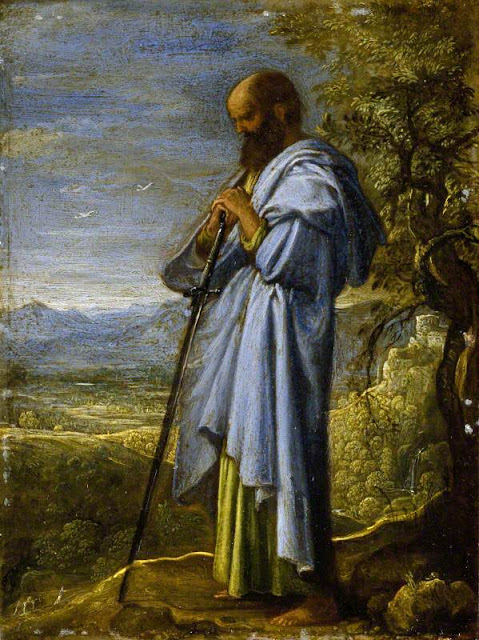 |
| Anonymous Italian Artist St Catherine of Siena receiving the Heart of Christ in exchange for Her Own ca. 1600 oil on canvas National Trust, Tatton Park, Cheshire |
 |
| Adam Elsheimer Judith and Holofernes ca. 1601-1603 oil on copper Wellington Collection, Apsley House, London |
 |
| Adam Elsheimer St Paul 1605 oil on copper National Trust, Petworth House, Sussex |
 |
| Adam Elsheimer Apollo and Coronis ca. 1607-1608 oil on copper Walker Art Gallery, Liverpool |
Coronis of Larissa was the fairest maide of face,
In all the land of Thessalie. Shee stoode in Phebus grace
As long as that she kept hir chast, or at the least as long
As that she scapèd unespide in doing Phebus wrong.
But at the last Apollos birde hir privie packing spide,
Whom no entreatance could persuade, but that he swiftly hide
Him to his maister, to bewray the doings of his love.
* * *
When Phebus hard his lovers fault, he fiersly gan to frowne,
And cast his garlond from his head, and threw his viall downe.
His colour chaungde, his face lookt pale, and as the rage of yre
That boylèd in his belking breast had set his heart on fyre,
He caught me up his wonted tooles, and bent his golden bow,
And by and by with deadly stripe of unavoyded blow
Strake through the breast the which his owne had toucht so oft afore.
She wounded gave a piteous shrike, and (drawing from the sore
The deadly Dart the which the bloud pursuing after fast
Upon her white and tender limmes a scarlet colour cast)
Saide Phebus, well, thou might have wreakt this trespasse on my head
And yet forborne me till the time I had bene brought a bed.
Now in one body by thy meanes a couple shall be dead.
Thus muche she saide: and with the bloud hir life did fade away.
The bodie being voyde of soule became as colde as clay.
Than all too late, alas too late gan Phebus to repent
That of his lover he had tane so cruell punishment.
– from book two of Ovid's Metamorphoses, translated by Arthur Golding (1567)
 |
| Annibale Carracci Pietà ca. 1603 oil on copper Kunsthistorisches Museum, Vienna |
 |
| follower of Annibale Carracci St John the Baptist in the Wilderness ca. 1600-1610 oil on canvas National Gallery, London |
 |
| Annibale Carracci Dead Christ Mourned (The Three Maries) ca. 1604 oil on canvas National Gallery, London |
 |
| Innocenzo Tacconi Assumption of the Virgin ca. 1603 oil on canvas Walker Art Gallery, Liverpool |
 |
| Domenichino Monsignor Agucchi ca. 1603-1604 oil on canvas York City Art Gallery |
 |
| Giuseppe Cesari Expulsion from Paradise ca. 1600-1610 oil on copper Wellington Collection, Apsley House, London |
 |
| Marcus Gheeraerts the Younger Henry Frederick, Prince of Wales ca. 1603 oil on canvas National Portrait Gallery, London |
"The sudden death of Henry, Prince of Wales from typhoid fever on 6 November 1612 sent shock waves through the Court of James VI and I. The unexpected death at the age of eighteen of the heir to the thrones of England and Scotland was a major blow to the Stuart dynasty, just as the equally sudden death of the fifteen year old Arthur, Prince of Wales in April 1502 had been to the first of the Tudors, Henry VII. James's dynastic hopes now rested on the shoulders of a single surviving son, Charles, Duke of York, just as Henry VII's focus had necessarily shifted to Arthur's only brother. However, whereas the future Henry VIII had been a robust young man, Charles was a physically poor specimen: his legs and ankles were so weak that as an infant he preferred to crawl, and as a child he had been required to wear specially made reinforced iron boots. His condition was almost certainly hereditary, since his father had not learned to walk until he was five. Many contemporaries clearly expected that Charles, who was not quite eleven when his brother died, would not survive to reach manhood let alone marry and produce heirs of his own. There was little likelihood that James himself would father another son. Although aged only forty-six, his wife, Anne of Denmark, was thirty-eight and so unlikely to bear him any more children. Even had he attempted to do so – and it seems unlikely that James continued to enjoy physical relations with his wife by this date – the risks were severe. When Henry VII tried to father another son in the wake of Prince Arthur's death the result proved fatal, both to his thirty-seven year old wife, Elizabeth of York, and to the baby."
– Andrew Thrush, The Death of Prince Henry and the Succession Crisis of 1612-1614 (Institute of Historical Research, School of Advanced Study, University of London)
 |
| Anonymous British Artist Captain Sir Thomas Dutton ca. 1605-1610 oil on canvas National Trust, Lodge Park, Gloucestershire |
 |
| Peter Paul Rubens Marchesa Maria Serra Pallavicino 1606 oil on canvas National Trust, Kingston Lacy, Dorset |
 |
| Peter Paul Rubens Cain slaying Abel ca. 1608-1609 oil on panel Courtauld Gallery, London |
 |
| Peter Paul Rubens Moses and the Brazen Serpent 1609-1610 oil on panel Courtauld Gallery, London |